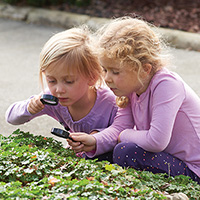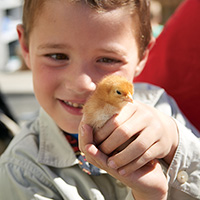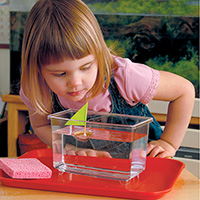
"Let the children be free; encourage them; let them run outside when it is raining; let them remove their shoes when they find a puddle of water; and, when the grass of the meadows is damp with dew, let them run on it and trample it with their bare feet; let them rest peacefully when a tree invites them to sleep beneath its shade; let them shout and laugh when the sun wakes them in the morning..."
—Maria Montessori, The Discovery of the Child
 Young children are joyful explorers of the natural world—fascinated by seashells, rocks, puddles, and almost everything around them. As we introduce the sciences to children, their initial experiences should ideally take place outdoors with real flowers, leaves, rivers, and animals. But how do we give children these outdoor experiences if our schools aren't located near woods, creeks, or ponds?
Young children are joyful explorers of the natural world—fascinated by seashells, rocks, puddles, and almost everything around them. As we introduce the sciences to children, their initial experiences should ideally take place outdoors with real flowers, leaves, rivers, and animals. But how do we give children these outdoor experiences if our schools aren't located near woods, creeks, or ponds?
Follow the child! Even in the most urban playgrounds, children will find roly-polies in a patch of dirt and a spider's web spun along the fence. With a little creativity, teachers can present a range of science activities outdoors and give children opportunities to explore the natural world right in their own schoolyard. Be sure children have boots and raincoats, so they can go outside even in the rain and snow. Take children on a walk around the school or neighborhood and ask them what they notice—what's growing up through the cracks in the concrete and how the wind or rain feels on their faces.
"...place the soul of the child in contact with creation, in order that he may lay up for himself treasure from the directly educating forces of living nature."
—Maria Montessori, The Montessori Method
 During my Montessori elementary teacher training, our instructor took the class outdoors to begin the study of leaf shapes. She invited us all to find a tree we particularly liked. "Then, " she said, "Ask permission of the tree to pick one of its leaves." This simple outdoor experience, combined with such reverence for all living things, has stayed with me over the decades. Since that time, I've tried to pass this spirit and awareness to the children I've taught. For young children, the message can be as simple as reminding them to "pick a leaf gently, so as not to hurt the tree."
During my Montessori elementary teacher training, our instructor took the class outdoors to begin the study of leaf shapes. She invited us all to find a tree we particularly liked. "Then, " she said, "Ask permission of the tree to pick one of its leaves." This simple outdoor experience, combined with such reverence for all living things, has stayed with me over the decades. Since that time, I've tried to pass this spirit and awareness to the children I've taught. For young children, the message can be as simple as reminding them to "pick a leaf gently, so as not to hurt the tree."
If your playground has even one tree, make the most of it! Invite children to collect leaves for rubbings and cones or acorns for observation under a magnifying glass. Feel the bark and find the roots that might be close to the surface. Set up an easel where children can draw or paint the tree in every season. Invite children to lie quietly on a blanket under the tree for an outdoor experience of the Silence Game. What do they hear? Leaves rustling? A squirrel scampering? A bee buzzing?
Give children the hands-on experience of trees, leaves, flowers, and animals before introducing the botany puzzles, leaf cabinet, and nomenclature cards. That firsthand experience with the living world will bring context and more interest to the children's further exploration with the materials.
A favorite lesson for many elementary students is constructing a river. Children dig a shallow trench at least five feet long, then build up the banks of the river with stones, dirt, twigs and pebbles. Finally buckets of water are poured into the headwaters and the work of water—carving, carrying, and depositing—is studied.
Younger children, ages 3-6 years old also love this river-building experience, even if they aren't yet ready for the more technical details about what's occurring. Just watching a leaf float down their child-made river is fascinating. If your school doesn't have a suitable patch of dirt, a smaller river or pond could be built in the sandbox. Float and sink experiments, using pebbles, leaves, twigs, and acorns can be undertaken on this pond or with the outdoor water table.
 Make a tiny boat using half of a walnut shell and a toothpick with a small paper sail attached to it. Stick the toothpick into a bit of clay secured inside the shell. Carefully place the boat on the water and then blow on the sail. Ask the children what they observe. This experiment is designed to demonstrate that air has the power to move the boat, but accept whatever conclusions the children come to.
Make a tiny boat using half of a walnut shell and a toothpick with a small paper sail attached to it. Stick the toothpick into a bit of clay secured inside the shell. Carefully place the boat on the water and then blow on the sail. Ask the children what they observe. This experiment is designed to demonstrate that air has the power to move the boat, but accept whatever conclusions the children come to.
When out in nature, encourage children to ask questions and describe what they see. Eventually they will begin thinking like scientists.
Adapt activities to their developmental stage. Children ages three to five are primarily interested in "what" is happening, so a lot of explanations aren't necessary. When children are older, they become interested in the "why."
Many science activities can be presented outdoors and are open-ended, with no right or wrong answers. Teachers have the opportunity to encourage children to keenly observe, make predictions, test theories, and draw conclusions—in other words, to think like a scientist. Regardless of the children's predictions and conclusions, don't correct them. The process of exploration is what is most essential.
Give children the gift of going outdoors for structured activities to learn about science as well as to observe, enjoy, and interact with the natural world.
"As long as I live, I'll hear waterfalls and birds and winds sing. I'll interpret the rocks, learn the language of flood, storm, and the avalanche. I'll acquaint myself with the glaciers and wild gardens, and get as near the heart of the world as I can."
—John Muir, The Journals of John Muir
—by Irene Baker, MEd, Montessori Educational Consultant at Montessori Services. She holds both primary (ages 3-6) and elementary (ages 6-12) Montessori certifications and has taught at all three levels. For over 20 years, she has served as a Montessori consultant and teacher-trainer for primary and elementary levels, and has presented workshops for teachers at schools and AMS conferences. Her work with students and teachers is infused with her passions: storytelling, history, social justice, non-violent (compassionate) communication, poetry, meditation, music, and the natural world.
—Originally Published 2019